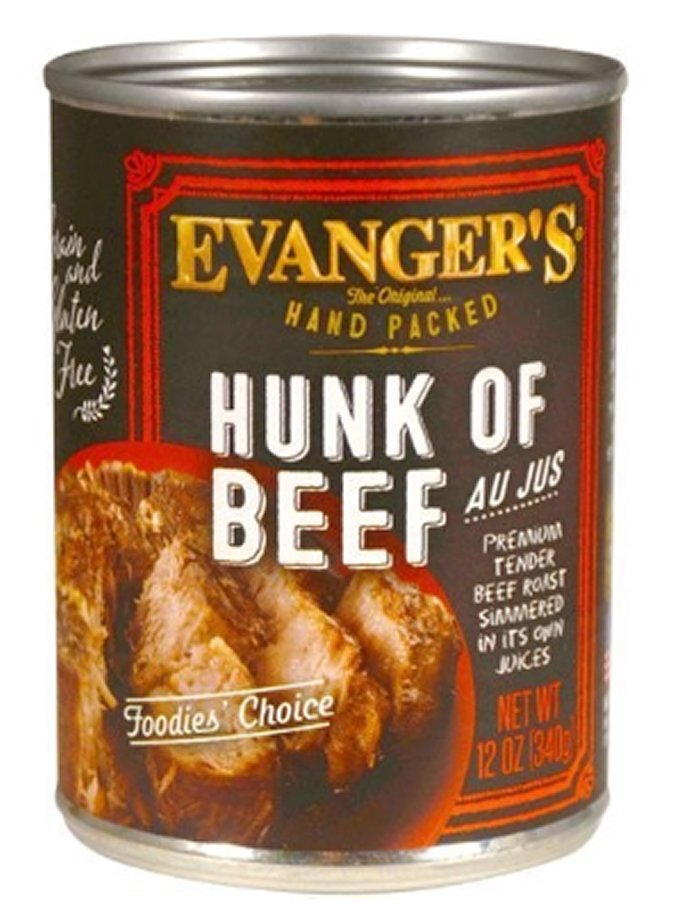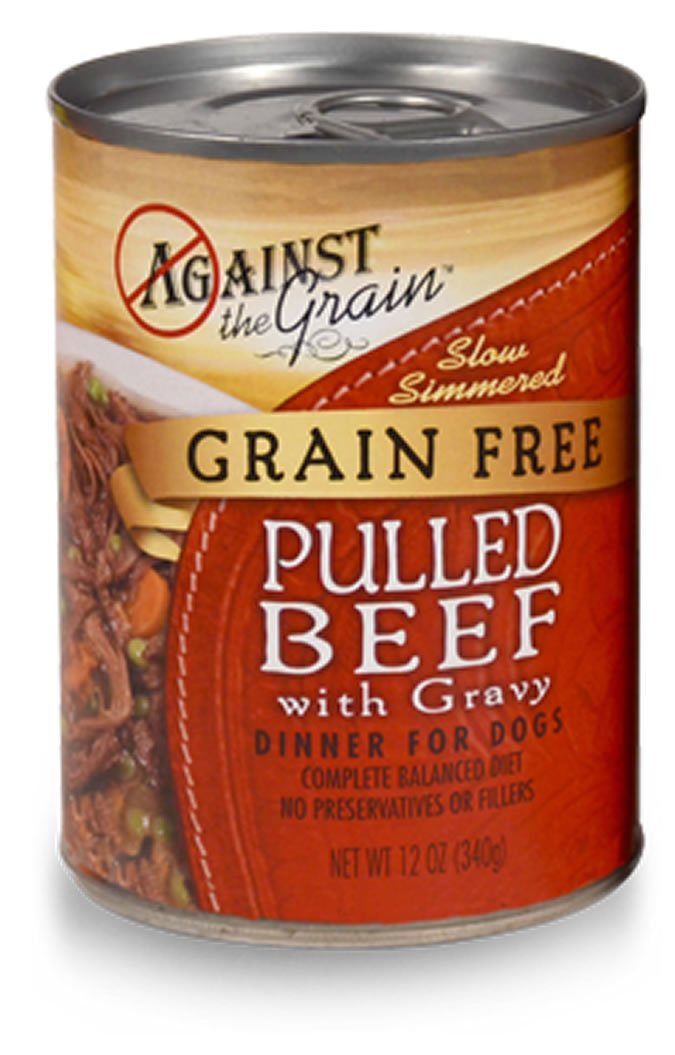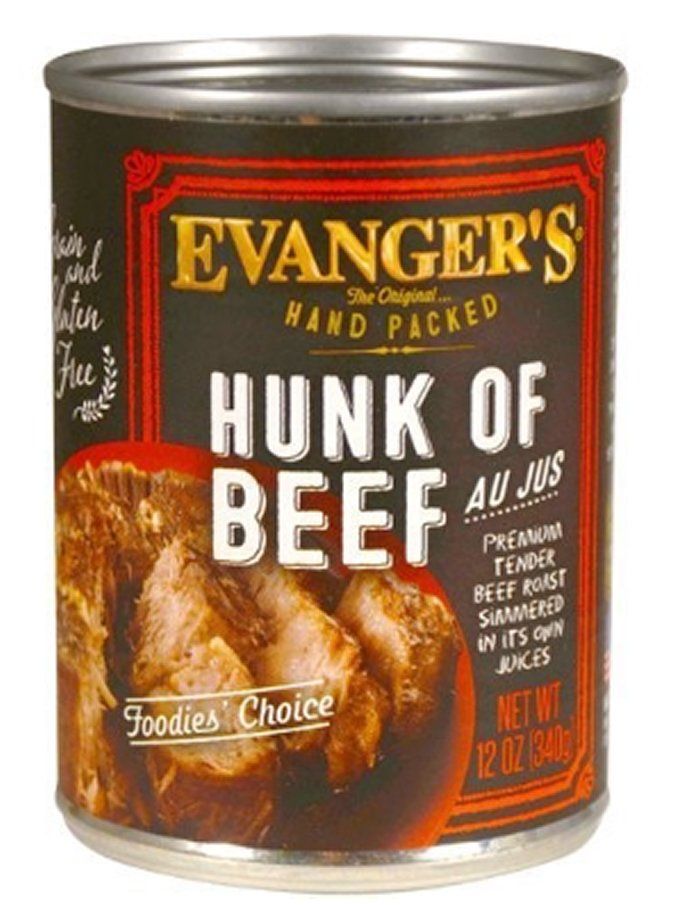
Just a few months ago we printed a front-page article assuring you, our readers, that despite rumors of unwholesome ingredients in commercial dog food, including remnants of dead dogs and cats, the store-bought pet food we feed our canine loved ones is wholesome, safe, and nutritionally balanced. We explained that dogs and cats who have died or been euthanized are rendered separately from animals used for food at plants inspected by the U.S. Department of Agriculture and therefore are not present in food produced by pet food companies who do in fact use meat from government-inspected facilities.
But after that article came out, reports started swirling in a number of major news outlets that Evanger’s Hunk of Beef canned food for dogs contains pentobarbital — a drug used to euthanize pet dogs and cats — and that at least four dogs became sick from eating the tainted kibble, with one having to be put down. Could it possibly be true? Or is it just another one of those Internet rumors?
It happened
Early in the year, five dogs in the same household became sick upon eating canned Evanger’s Hunk of Beef, according to a company announcement that was subsequently posted by the Food and Drug Administration. The FDA then reported that all five dogs went into intensive care units, or ICUs, but one died and one remains on anti-seizure medication — not surprising since ingestion of pentobarbital can cause neurological symptoms that include dizziness, loss of balance, nausea, drowsiness, and excitement. The FDA subsequently confirmed in an official report that the euthanasia drug pentobarbital was found in two cans of Against the Grain — a pulled-beef product with gravy that is made by the same family that owns Evanger’s.
According to Evanger’s, tests appear to indicate that the pentobarbital came not from rendered dogs, cats, or cattle (which are rarely euthanized the way pets are, with injections of drugs) but from horses — animals that do get euthanized with pentobarbital, but which were not on the food’s ingredients list. Lab investigations show that horse DNA was found in the food. It wasn’t supposed to be there. Horsemeat, while eaten by people and animals in a number of other countries, is not considered socially or culturally acceptable as food in this country. We have not a single equine slaughterhouse within our borders.
The finding about the contamination initially led Evanger’s to recall 60,000 cans of Hunk of Beef manufactured at the same time as the can containing the pentobarbital. They had been distributed in more than a dozen states in every area of the country and have expiration dates of June 2020, so they might very well be in your cupboard. The FDA says that since the initial illnesses, it has received additional complaints from consumers who fed Evanger’s Hunk of Beef to their dogs, in some cases exclusively, meaning that other foods can be ruled out as culprits.
Evanger’s has since expanded its recall and has now included a third brand: Evanger’s Braised Beef. Twelve-ounce cans with the following barcodes should not be fed to your dog, says the FDA:
Evanger’s Hunk of Beef: 20109
Against the Grain Pulled Beef: 80001
Evanger’ Braised Beef: 20107
These numbers are the second half of the barcode, which can be found on the back of the product label. They have expiration dates of December 2019 through January 2021. Consumers can return recalled cans to the store at which they were purchased for a full refund.
The blame game
In publicity releases, Evanger’s puts the blame squarely on its beef supplier. “The guilty party has turned out to be one of our most trusted meat suppliers,” the company says, and has announced that it has ceased doing business with that firm. Evanger’s also says it aims to “force the FDA to put an end to allowing drugs like pentobarbital to enter the raw material stream.”
To be clear, the FDA does not allow pentobarbital in food. The government agency says, in fact, that the presence of that drug is considered a product adulteration in violation of the Federal Food, Drug, and Cosmetic Act. It makes sense in light of the fact it is used to euthanize only those animals not meant for consumption — either by people or other animals.
This is not the first time Evanger’s and the FDA have been on opposite sides of an issue concerning mislabeled food. In 2011, the FDA sent Evanger’s a warning letter after tests showed that its dog (and cat) foods containing lamb and duck contained beef instead. This go-round, despite Evanger’s assertion that all of its ingredients come from USDA-inspected plants, the government agency’s preliminary assessment indicates that none of Evanger’s suppliers are facilities registered to receive inspections by the USDA’s Food Safety and Inspection Service.

What you can do
The information is troubling. Evanger’s is a company whose products are sold throughout the U.S. That said, you do not have to panic. “Pet food-associated illness is exceedingly rare,” says Tufts board-certified veterinary nutritionist Cailin Heinze, VMD, DACVN. In fact, she points out, “recalls of pet food are quite rare compared to recalls of food for people.” And, she adds, recalls of pet foods do not usually happen because they have made an animal, or animals, sick. It’s because upon testing, the company finds that a food is contaminated, but it has already been shipped. The firm calls it off the shelves before any harm is done. Another way of putting it: the quality control system, for the most part, works.
But is there anything you can do to make sure your dog — or other people’s dogs — do not become an unwitting victim? Yes. You can never erase risk completely, just as you can’t completely erase risk in food you buy for yourself. You can, however, take some important steps.
- Don’t feed your dog raw food, whether homemade or commercially prepared. This may sound unrelated to the case at hand, but the majority of recalls of pet food these days is for raw foods found to be contaminated with bacteria, usually Salmonella. A dog who ends up infected with Salmonella can develop gastrointestinal problems ranging from mild to severe. She may also be feverish, and in rare cases, the infection can progress to a life-threatening full-body stage called septicemia. Why take that chance? Again, reports of actual illness from commercial pet folds sold raw are rare. But that said, they are much less commonly fed than cooked kibble or canned foods. Furthermore, raw dog food does not offer any nutritional or other health advantage compared to cooked food, so why take that chance?
- Don’t buy products from a company that has received warnings from the Food and Drug Administration about adulteration of its food or major violations on inspection of its manufacturing plants, especially if such warnings have occurred more than once over the course of time. It’s a bit tricky when you start googling, Dr. Heinze says, because there’s so much false information online that impugns even perfectly reputable pet food companies. Some people simply have an innate distrust of food manufacturers, and they express that distrust on the Internet whether it is valid or not. But FDA communications are different; they come from the very agency in charge of keeping pet food safe, and that agency doesn’t make spurious accusations. So if the FDA has published press releases or other warnings about a company, those communications should be taken seriously.
- Call the company to see if it has one of the following on its full-time staff: a board-certified veterinary nutritionist, someone with a PhD in animal nutrition, or a veterinarian with a PhD in nutrition. Using one of these as a consultant who is not on staff is not enough. “If you’re paying a consultant by the hour,” Dr. Heinze says, you’re more likely to say, ‘Oh, I’ll handle this.’ But if you’re paying someone a salary, you’re going to go talk to them immediately if there’s a problem.” And a full-time employee is likely to watch more closely for problems because it’s their primary responsibility. If a company doesn’t give you a straight answer about whether one of these highly trained nutrition professionals is on staff, that’s a major red flag.
- When you buy dog food, “you should never ever dump it out of the bag and into a Tupperware or other container and not keep the date code and other numbers on the label,” Dr. Heinze says. Those numbers provide information about what lot the food came from and when it was manufactured. If a problem does arise and the numbers have been tossed, the company has no way to track down the lot and test it for contaminants — and potentially protect other dog owners from inadvertently making their canine loved ones ill. “It’s best to keep the food in the bag that it came in,” Dr. Heinze says. “Some bags have advanced technology for keeping food fresh. If you do want to use plastic containers, just put the whole bag in the container. Or, if you’re going to pour the food from the bag into the unlabeled container, cut out the date and other codes and either put that part of the label in with the food or somewhere else” in the kitchen, in case you come to suspect that the food has made your pet ill.
- Know when to suspect that the food your dog has eaten may be what made her sick. There are two big warning signs, Dr. Heinze says. One is if you notice that your dog suddenly has decreased interest in a food she has always loved when you feed her from a newly opened bag or can. It could be that the food is rancid or that something else is wrong with it. Of course, it could also be a coincidence — but contaminated food is something to consider. The other warning sign is multiple dogs in a household developing similar symptoms hours after eating the same food. (That’s what happened in the household where multiple dogs became ill after eating the Evanger’s canned food.)
- If your dog becomes sick and you believe the food you fed her might be the culprit, save some of it. Again, this speaks to potentially protecting other dogs whose owners bought food from the same lot. “Grab a couple of zip lock bags and put some of the food in the fridge or freezer,” Dr. Heinze says. “If it’s wet food, save a few cans. The FDA might want to test it, so they’ll ask for samples, and the company will want to test it, too.”
- Take your dog to the vet. “Do not go on the Internet to diagnose your pet,” Dr. Heinze exhorts. This is not only so your pet won’t be misdiagnosed. It’s also because the more detailed the medical records, the more likely it is that your vet and the FDA will be able to determine whether the food really was the culprit. If you don’t have the proper blood work, imaging tests, and other diagnostics, you’ll never know for sure. Sometimes the food manufacturer will pay for the testing if you call and express your concern and it seems possible that the food was involved.
- If your vet thinks it’s possible that contaminated food caused your dog’s illness, report the incident to the FDA. Better yet, ask your vet to do it. The doctor and the FDA speak the same language when it comes to issues of food contamination. The FDA has a Safety Reporting website portal (safetyreporting.hhs.gov) that’s very easy for both vets and pet owners to use. The doctor can upload medical records and related information.
- Call (or talk to your vet about calling) the food manufacturer to give the company a heads-up. If the company is legitimate, they will ask for the lot number so they can begin testing.
- Call (or talk to your vet about calling) your state’s feed control official. To find that person, go to aafco.org/regulatory. You’ll see a map of the U.S. Just click on your state to get contact information. Note: All of these calls and reports — to the FDA, to the manufacturer, to your state feed control official — should happen only after you’ve taken your dog to the vet, and only if she shares your suspicion that food could have caused your pet’s illness. “People tend to blame illness on food,” Dr. Heinze says, “and there’s often a reason for a dog’s sickness that’s not food-related.”
- If your dog dies and you think it’s related to food she ate, have a necropsy (animal autopsy) performed, preferably by a university or a board-certified veterinary pathologist so that you are assured of having impeccable medical records. In the case of death, the only way to ascertain whether food was the culprit is to go this route. If the necropsy costs more than you are able to pay, talk to the food manufacturer about taking care of the bill. “A reputable company will want to know as much as you do whether their food caused the death,” Dr. Heinze says.
We cannot stress enough that it’s very rare for a food to make a dog sick. “Many illnesses blamed on the diet are not diet-related,” Dr. Heinze says. But following these 11 steps will help you avoid even the extremely slight risk of feeding your dog adulterated food and will help others who bought food from the same lot if the food does cause a medical problem.






“majority of recalls of pet food these days is for raw foods found to be contaminated with bacteria, usually Salmonella.”
THIS IS NOT THE CASE!! This article needs to be updated with new studies!
You want gastrointestinal problems and disease, feed kibble